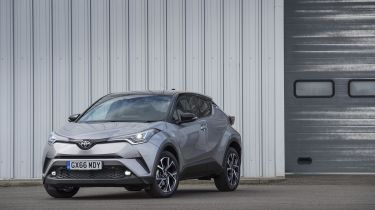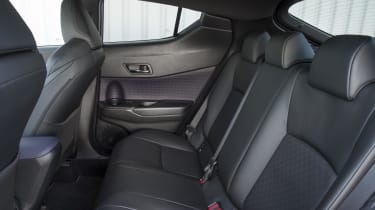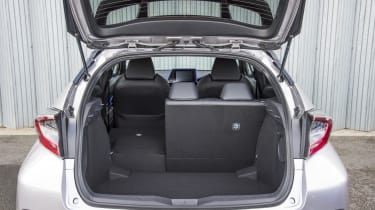Toyota C-HR Hybrid - Practicality & boot space
Good practicality given the sleek shape, but check children are happy with the view from the Toyota C-HR Hybrid’s rear windows
If you’re sold on the looks of the Toyota C-HR Hybrid, deep down you probably know a boxier SUV would be more practical. To give the C-HR its due, it could have been a lot worse – that sloping roofline impedes rear headroom slightly, for instance, but it doesn’t make carrying adults in the back of the C-HR impossible by any means.
Toyota C-HR Hybrid interior space & storage
We’ve no complaints in the front of the C-HR. Two cupholders and a large cubby mean the central console is put to good use, while the glovebox is large enough to swallow a big bag of crisps. The large windscreen and high seating position make for a pleasant view out, while our testers found the driving position good.
Coming around to the rear and – as long as your children are tall enough to reach the high door handles – room in the back is reasonable, with enough legroom for adults and okay headroom – though anyone over six foot tall will find their head brushing the ceiling. Getting three people back there will – depending on their size – also be a bit of a squeeze, though the transmission tunnel hump is minimal.
Potential customers with small-ish children should take them along for any test drive, though, as the rear windows are high, narrow and set fairly far forwards, so may provoke feelings of claustrophobia. Of course, there’s always the chance your kids will think the C-HR cool enough to overlook the impaired view out.
Boot space
The C-HR Hybrid has the same cargo capacity as the 1.2-litre petrol model so you get a 377-litre boot, which is small by SUV standards; for comparison, the Volkswagen Golf has a 380-litre boot, while the SEAT Ateca – a more direct rival – has 485 litres under its tailgate.
Drop the 60:40 split-folding rear seats and the C-HR’s boot obviously grows significantly in size, but while the seats lie reasonably flat, they don’t do so totally, and the folding mechanism is accessed from the rear seats, not the boot. There’s also a fairly pronounced load lip and no clever under-floor storage.
These are niggles rather than serious issues, however, and many will feel the drawbacks brought by the C-HR’s sloping roofline and sharp rear end are outweighed by the car’s undeniable sense of style and panache.
Towing
The Toyota C-HR Hybrid is rated to tow a maximum braked trailer weight of 725kg. This is less than the 1.2-litre model, which can pull up to 1,110 kg.














